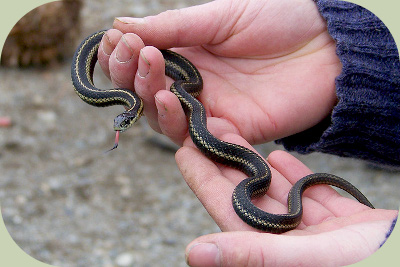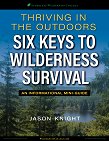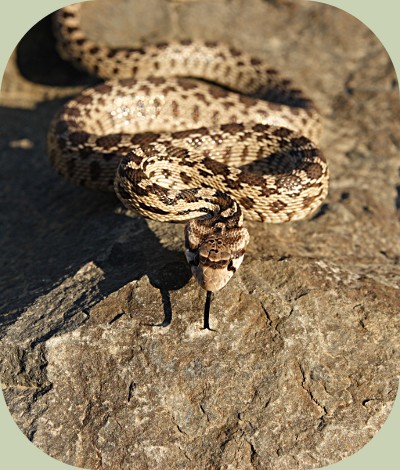Identify Snakes: A How-to Guide

Ever wondered how to identify snakes? Well, with 120 species found in North America, North of Mexico it can be a challenge. Here are some things you can look for and think about to help you identify snakes. Let's look at some basics first.
What is a snake?
Snakes are members of the class of animals known as reptiles (Reptilia), and are further divided into the order Squamata – which includes lizards, and are in the suborder Serpentes. In other words, they belong to a family of animals with dry, scaly skin which lay tough-shelled eggs on land and depend on the external warmth from their environment to maintain their body temperatures. Snakes in particular are animals without limbs and elongated bodies. Snakes have no external ear openings, nor any eyelids.
A snake can't blink its eyes, ever! Their eyes are covered by a transparent scale similar to a contact lens, which is shed along with the snake's skin several times a year. Lack of movable eyelids helps separate them from legless lizards. Another thing that can help you identify snakes is knowing that they shed the entire skin from their body at one time. This is done by rubbing up against an object and rolling the skin off from head to tail so that it ends up inside out like an extremely long sock. All snakes are carnivorous and swallow their prey whole. Snakes grow throughout their lifespan, but growth tends to slow down after they reach adulthood.
The presence of a long, two-pointed, forked tongue helps you identify snakes. Snakes depend on their tongue for a great deal of information. They do not smell through their nostrils like mammals, rather they smell using their tongue to collect scents and then insert them into the roof of their mouth, where lies the Jacobson's organ. This organ helps interpret the different scents and guides snakes to potential food or mates, as well as away from potential danger. The tongue of a snake is not harmful.
Snakes kill their prey in several different ways. Some species use venom, which they inject through their fangs. Other snakes use constriction, and squeeze their prey until it stops breathing. Also, many snakes simply grab their prey, overpower it and start swallowing. Snakes have jaws that are hinged and can expand in several places, allowing them to swallow prey bigger than their own head.

Where and when can you find snakes?
Snakes are ectothermic, meaning they rely on external warmth to maintain their body temperature. Therefore, in the parts of the world where it is warm throughout the year, like in the tropics and subtropics, snakes can be seen anytime of the year. While in the more temperate or colder parts of the world, snakes are only active during the warmer months. In some areas, snakes will hibernate for several months of the year.
Snakes are found in a wide variety of habitats, ranging from forests, woodlands, fields, meadows, mountains, prairies, riparian areas, wetlands, swamps and many other natural habitats. Some snake species also live in rural areas around fields, pastures and buildings. A few species even live in urban areas.
If you are looking for snakes, consider looking in some of the habitats mentioned. Especially look in areas where there are logs, rocks, woodland edges, under large pieces of natural or man made debris. Warm sheets of metal or cardboard as well as large, thin, and flat rocks provide excellent cover objects for snakes.
Are snakes dangerous?
Of the 120 species of snakes in the USA, only 17 are a potentially hazardous to humans. These snakes are not "poisonous," rather they have venomous saliva which is injected when they bite. It is important to identify snakes that belong to the venomous group. Most snake species are harmless and even the venomous species are worth studying, though with respect. Please, do not try to handle any dangerous species.
Snakes are beautiful animals, with amazing forms, colors and behaviors. They are not slimy to the touch, but have a pleasant feel that some have compare to the texture of oiled leather. The shape, color and size of the eyes of these animals can reveal a lot about their lifestyle as well as help you identify snakes. Snakes with tiny eyes – such as those of blind snakes – tell of their subterranean existence. Snakes that have eyes with vertical pupils tend to be largely active at night. Vertical pupils do not necessarily indicate that the animal is dangerous, as many non-venomous snakes also have them. Most snakes have round pupils, but a few have long, horizontal pupils which give them excellent binocular vision.

Key field marks for identifying snakes
One of the simplest ways to identify snakes is by breaking their identification down to key field marks. These are aspects of the snake's appearance which make it unique as a group or species. Here is a list of some of the best ones to use:
Body Type: Is the body type slim and long, medium thickness and long, or short and stout? Is it large or small? Approximately how long?
Head Shape: Is the head shaped like a broad arrowhead, like a spade, or like an oval? Does it have a distinct neck?
Eyes: Are the eyes large or small? Does it have rounded or vertical pupils? Are there scales that jut out over the eye like an eyebrow? What color are they?


Scales: What texture are the scales, rough or smooth? Do some or all of the scales have keels(raising lines running lengthwise through scale)?
Patterns: What kinds of patterns does the snake have?
- Blotches: large blocks of color that are irregular or rectangular, often with dark borders.
- Diamonds: large, diamond shaped markings of one or multiple colors.
- Speckles: one or more dots or flecks of color per scale.
- Spots: are small, rounded marks generally without borders that can cover several scales.
- Crossbands: Bands of color that go across the back and down the sides, but don't cross the belly.
- Rings: Are bands color that go across the back and down the sides, completely encircling the body.
- Stripes: are lines of color run lengthwise down the snake's body. They may be only a scale wide or may be many scales wide.
- Two-toned: Where the back and belly are different colors.
- Head and neck colors: Some species have distinct markings or colors on the head in the form of bands, stripes or solid areas of color.
- No pattern: The body is a single, uniform color.
Color: Which color(s) is the snake? What color are the patterns on it?
Anal scale: Some species can be distinguished by looking at the scale that covers their cloaca (an opening used both for getting rid of waste and during reproduction). If it is safe, gently turn the animal over to see whether this scale is single, or divided into 2 scales. This procedure is often not needed to identify snakes of many species.
Tail: What shape is the tail? Does it end in a rattle or pointed scale? Is it a blunted end? Is the tail long (tail measured from the cloaca back to the tip)? Is the tail a different pattern?
Other features: Other features that some more in-depth systems use to identify snakes might include: looking at the size and arrangement of scales on the head and face, and counting the scale rows across the back. These can be learned about in more detail by using the other resources mentioned at the end of this article.
Other considerations: keeping a naturalist journal
When you identify snakes in the wild, it can be tremendously helpful to keep at least a basic naturalist journal. This information can be used later to help you find more snakes, and help you learn much more about them and their environment.
Take notice of things like: location, time of year/day, habitat and microhabitat. When recording location, consider taking note of the geography both big picture and small. Think about the state you are in, the nearest town, the nearest major landmark such as a valley, mountain range, river, etc. Record what the date, time of year, weather and time of day were when you observed the animal. Also, record the overall habitat of the location. For instance, describe whether you found it in a pasture or a riparian woodland along a stream. Also, record and describe the microhabitat such as the specific location of the exact spot you found it. Maybe it was a pile of rocks, or under a log on the South side of the stream and up on the raised stream bank. Many snakes are very specific about the microhabitats they use in their preferred habitat and knowing those will help you zone in on their exact whereabouts.
Be More Prepared For Your Next Outdoor Adventure!

Don't leave home without knowing these six essential survival skills. Our free survival mini guide reveals the strategies of:
- Shelter & fire to prevent the number one cause of death
- Obtaining clean water to avoid life-threatening dehydration
- Common wild survival foods and other critical skills!

How to identify snakes: an example
Imagine for a moment that you are walking along in the open, dry and hot sagebrush steppe of eastern Washington State, a trusty field guide to the local wildlife tucked away in your pocket or bag. As you pass a pile of rocks, you spot a snake curled up on top soaking up the sun. You get excited and try getting closer. As you do, the snake flattens out its head, puffs up its body and raises it's head, while coiling up. It is starring at you, and looks ready to strike. They you hear a whirring-hissing sound coming from it: T-t-s-s-s-s-s-s-S-S-S-SHHH! You notice that the end of its tail is vibrating quickly. As you lean closer, it strikes at you repeatedly!

What now?
You know this is pretty unusual, as you have seen snakes before and never had one act this way. Notice the details of this animal. Let's break it down into the key field marks and see if you can use your knowledge of how to identify snakes.
Body type: This animal has a medium body, which now appears much thicker after it puffed itself up. It is between 2 and 3 feet long.
Head shape: Well, this is tricky. You can remember the head started out kind of long and narrow, but now it looks much more arrow shaped and flatter. You notice that the nose end has a large scale on it that makes it seem a little cone shaped.
Eyes: The eyes look medium sized and have rounded pupils. No scales jut out over the eye. The eyes are brownish in color.
Scales: The scales looked keeled on the back and progressively less keeled onto the sides.
Patterns: The snake's body is covered with blotches forming regular patterns down the back and sides. A blackish-brown crescent is present between the eyes. A black teardrop line drops from the center of each eye, while a second brownish line tapers down from the back of the eye at a 4 degree angle. There are some more faded brownish marks and black spots on the head.
Color: The background color of the snake is a pale tan color. The large blotches start out blackish behind them head, fading to brown as they move down the body and again becoming blackish towards the tail.
Anal Scale: Not sure yet. You don't want to risk handling the animal yet, especially since you need some help to identifying snakes in this area.
Tail: Its tail tapers to a point covered in black blotches.

Now, you pull out your field guide you brought along to help you identify snakes. You can see that the animal's tail does not end in a rattle. Match up all the other field marks, and see what your possibilities are. According to the field guide, you learn there is only 1 potentially dangerous venomous snake in eastern Washington State, the western rattlesnake (Crotalus viridis). Unlike this serpent, the rattlesnake species has eyes with vertical pupils, a rattle at the end of its tail and heat-sensitive pits in its face, one on each side, between the nostrils and eyes. Rattlesnakes also have a more robust body which is proportionately shorter.
This is not a rattlesnake, so you know you are safe. The field guide shows a match, the great basin gophersnake (Pituophis catenifer deserticola). To identify snakes of this species it can sometimes be helpful to know about their possible behaviors in response to potential predators. The book mentions that these snakes sometimes behave in a way that makes them seem much more dangerous, by flattening out their heads, puffing up their bodies and vibrating the end of their tails rapidly. This along with their loud hissing makes them appear similar to a rattlesnake. Gophersnakes, however, are a harmless and generally gentle species.
At this point the animal has relaxed considerably and you decide to pick it up. It relaxes fully in your hand, and shows no sign of wanting to bite anymore.

Further Resources
Snakes are a diverse and awe-inspiring group of animals. If you wish to learn how to identify snakes, dedicate some time to getting familiar with the process of identification. Visit zoos, pet stores, and especially go and find them in the wild and not-so-wild places of the outdoors. When you find some, use your skills of observation and see if you can practice your ability to identify snakes.
Also, invest in a good local field guide for your region. Some excellent ones to start with are: The Audubon Society Field Guide to North American Reptiles & Amphibians by Bebler and King, Peterson Field Guide Series to Reptiles and Amphibians by Robert C. Stebbins, Snakes of North America: Western Region by R.D. Bartlett and Guide and Reference to the Snakes of Eastern and Central North America by R.D. Bartlett.
There are also some good regionally based resources online to help you identify snakes:
By the way, when you're spending more time in nature it's important to know how to stay safe in the outdoors, especially if you were to get lost. Right now you can get a free copy of our mini survival guide here, where you'll discover six key strategies for outdoor emergencies, plus often-overlooked survival tips.
References: Storm & Leonard 1995, Stebbins 1966, St. John 2002 and Behler 1979.
Related Courses:

About the Author: Filip Tkaczyk is a periodic guest teacher at Alderleaf. He also wrote the field guide Tracks & Sign of Reptiles & Amphibians. Learn more about Filip Tkaczyk.
Return from Identify Snakes back to Wilderness Articles
Is The Essential Wilderness Survival Skills Course Right for You? Take the "Online Survival Training Readiness" Quiz
See for yourself if this eye-opening course is a good fit for you. It takes just a few minutes! Get your Survival Training Readiness Score Now!

Grow Your Outdoor Skills! Get monthly updates on new wilderness skills, upcoming courses, and special opportunities. Join the free Alderleaf eNews and as a welcome gift you'll get a copy of our Mini Survival Guide.

 The Six Keys to Survival: Get a free copy of our survival mini-guide and monthly tips!
The Six Keys to Survival: Get a free copy of our survival mini-guide and monthly tips!
Learn more